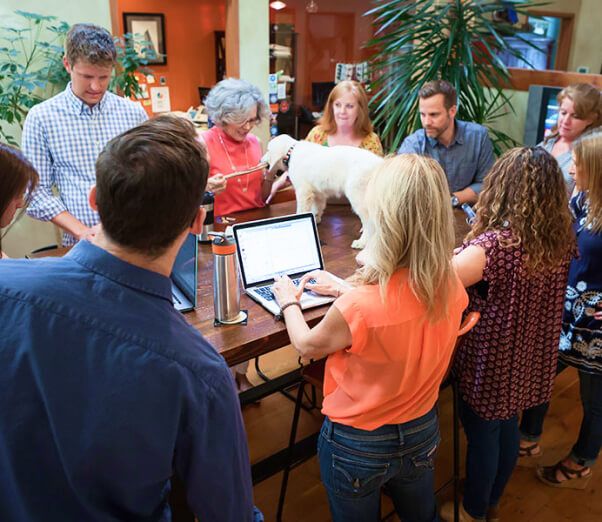Intuition in Business: How to Act on Your Guidance
This is the third of three guest blogs by international spiritual medium and bestselling author Rebecca Rosen.
Some of us are naturally wired as left brain dominant (logical or intellectual), while others are more right brain dominant (creative, intuitive and emotional). If you’re right brain dominant, it may be easier to tap into and develop your intuitive guidance. If you’re more left brain dominant, it may take a little more work to learn to use your intuition more regularly. But the work is worthwhile because spreadsheets, numbers and linear thinking only get you so far. The combination of intuition and intellect is where the real magic happens — in business, it’s the one-two punch.
Now that we’ve learned how to differentiate between intellect and intuition, and recognize the direction we’re receiving from our internal compass, we must learn how to combine the two and act on them. Below are the steps you can take to begin to align with your higher self and your right brain, ask for guidance, and then act on it.
Intuition often requires us to take a leap of faith, since it doesn’t initially have the numbers and data to back it up. The evidence comes after we choose to trust it, so be sure to pay attention to not only the intuitive hits you receive, but also what happened after you chose to act on them.
Step 1: Incorporate Meditation and Raise Your Vibration
Meditation has been an extremely important spiritual tool for me and it is becoming a more widely accepted daily practice for countless others. It’s a way to clear the mind chatter, what I sometimes call the “party in my head.” In getting to this place of stillness, quiet and neutrality, we get a clearer read on the information we have, where we want to go, and how to move forward.
Meditation is versatile and it doesn’t always require sitting in one place for extended periods of time. Moving meditations, like walking or exercising, are just as effective at helping you get out of your head. For some people, cooking, driving, gardening and painting are other effective forms of moving meditation. Any activity that helps you to quiet your mind and get into a “zone” can help you reconnect with your higher self and tap into the right brain. Finding more time to do meditation–in whatever form works for you–will also help you to more regularly raise your vibration, matching the frequency that allows you to access intuition.
While meditation helps clear the mind for more intuitive clarity, our “aha” moments may not always come while we’re sitting in lotus position or doing downward dog yoga. They may happen after the fact, in the minutes or hours following meditation, which is why it’s important to make meditation a daily practice.
Step 2: Ask For Next Steps
Connecting with our intuition starts with an intention followed by an invitation. We have to ask for the intuitive guidance that we’re hoping to receive and then remain open enough to receive it. Set your intentions each morning or before you meditate. This is your way of asking for what you need and requesting next steps through your intuitive guidance. Then, when you meditate, that’s when you make room to receive them with your quieted mind and open heart.
Step 3: Receive
Once you welcome that connection with your intuition and your higher self with your words or thoughts, you’ll begin receiving signs and downloading intuitive hits and information. Again, those hits may not come to you during meditation or even right at the moments that you’re expecting them. Putting out the invitation does not mean that we receive information on demand. Remember that intuitive information often comes from nowhere or “out-of-the-blue:” sometimes you just know, have a feeling, or hear or see ideas play out in your head.
When we keep an open mind and do more of those activities that facilitate the connection with our right brain, higher self, and intuition, we leave the door open for more signs and synchronicities that will answer the questions we have, validate the decisions we’re making, or guide us forward in the direction we’re wanting to go.
Step 4: Put It To The Test
How can you tell if incorporating your intuition into your decision-making process has paid off? It gets tricky when it comes to intuition, since you often just have to wait and see before you receive the validation that data and numbers may generally offer you. But by simply paying more attention to how you’re making your daily decisions and then tracking the outcome, it can become easier to recognize the ways that combining intellect and intuition can be used as an effective business tool.
Start by keeping a log of the decisions you make and then updating that log as they pan out. Did you make the decision purely from intellect? Was it an intuitive hit that spurred you to act? Or did you combine the two, using the left and the right brain to reach a conclusion and move forward? Try to pinpoint which decisions can be attributed to which process and then refer back to it as you go.
You may be surprised at how many decisions you make with instinct, especially the more you follow the steps above and better understand the intuitive hits you receive. Seeing this data on paper will hardwire confidence into your ability to make sound decisions and may inspire your willingness to use more than just intellectual data in your professional life.
Step 5: Trust the Process
Your intuitive process is a daily practice and uniquely yours, so give yourself some space and grace to explore what that looks like for you, knowing there is no one-size-fits-all formula. Take what works and leave the rest, trusting that your sincere intention to bridge the gap between your intellect and intuition is what matters most. Drawing upon both your intellect and intuition opens a doorway to a broader, clearer picture and perspective of the minutiae of everyday life, helping you to stay aligned with your career goals and overall purpose, while navigating them with more grace, ease and confidence.
Rebecca conducts regular small group readings, where she brings people messages from their departed loved ones. Enter here for a chance to win a virtual small group reading seat.



